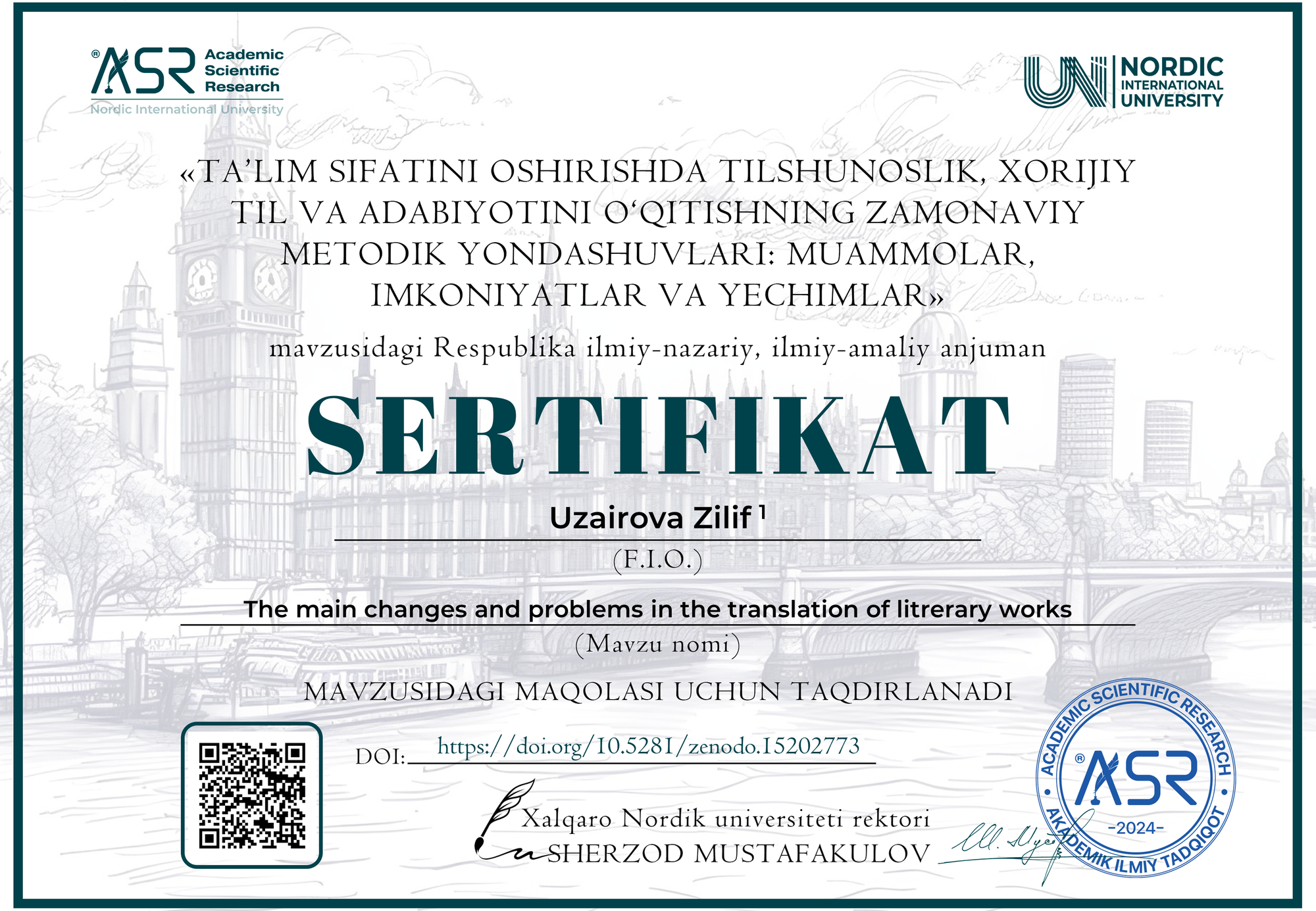Uzairova Zilif 1

DOI: https://doi.org/10.5281/zenodo.15202773
Google scholar: https://scholar.google.com/scholar?hl=ru&as_sdt=0%2C5&q=%22THE+MAIN+CHANGES+AND+PROBLEMS+IN+THE+TRANSLATION+OF+LITRERARY+WORKS%22&btnG=
Zenodo community: https://zenodo.org/records/15202773
Nordic_press journal: https://research.nordicuniversity.org/index.php/nordic/article/view/2366
MAQOLANI YUKLAB OLISH
SERTIFIKATNI YUKLAB OLISH
REVIEW:
Uzairova Zilif's article on the challenges and intricacies of literary translation provides valuable insights into the complex relationship between language, culture, and translation theory. The author aptly highlights the cultural adaptations that translators often make to ensure that a literary work resonates with the target audience, thus preserving the essence of the original text while making it accessible to different linguistic and cultural contexts.
The article opens with a clear and concise explanation of how each language is closely tied to its culture, history, and way of thinking. This premise serves as a solid foundation for understanding the difficulties faced by translators, especially when translating literary works that contain cultural nuances, idiomatic expressions, and references that may not have direct equivalents in the target language. By presenting the varying approaches to translation, the author effectively engages readers in the debate about whether to prioritize faithfulness to the source text or cultural adaptation for clarity and understanding.
In discussing the evolution of translation theory, Zilif provides a brief yet informative overview of the contributions made by notable linguists and translators, such as Danila Seleskovitch and Peter Newark, whose views on the educational and cultural functions of translation are thoroughly examined. The article also sheds light on the historical development of translation in Uzbekistan, pointing out the early challenges faced by Uzbek translators, many of whom translated from Russian rather than the original texts. This historical context is crucial for understanding the development of the Uzbek translation school and its efforts to adapt foreign works to local readers.
The author also explores the role of technological advancements in translation, particularly in the context of translating technical and scientific terms that might not have existed in the target culture. By citing examples from the translation of computer technology terms into Xhosa, Zilif demonstrates how such terms require creative strategies, including approximation or extended explanations, to ensure accurate communication.
One of the article's strongest points is its discussion on the difficulties specific to literary translation, such as the challenges of translating poetry. By referencing Roman Jakobson’s assertion that poetry is "untranslatable," the author underscores the significance of stylistic and formal features in literary works and how these features often present challenges when translating. Zilif also emphasizes the importance of balancing literal translation with paraphrasing, as demonstrated in the comparison of different translators' approaches to the Turkish novel İnce Memed. This highlights the importance of the translator's individual style and the impact it has on the final text.
The article concludes by reiterating the importance of translation as a means of bridging cultural divides, stressing that literary translation is more than just a language transfer—it is a means of transmitting culture, preserving the original author's intent, and making literary works accessible to global audiences. Zilif rightly notes that despite the advances in translation theory and technology, there remain significant obstacles, such as untranslatable concepts and the preservation of artistic integrity.
In terms of improvements, the article could benefit from more concrete examples of specific translation issues and solutions faced by translators in the context of Uzbek and other languages. Additionally, a more detailed exploration of modern technologies, such as machine translation and AI-driven tools, would have been valuable in showcasing how the field has evolved with the advent of digital tools.
Overall, Uzairova Zilif’s article provides a thorough examination of the main challenges in literary translation, offering both theoretical perspectives and practical insights. The author successfully highlights the complexities of translation as both an art and a science, underscoring its role in promoting cross-cultural understanding and communication.



